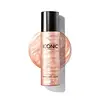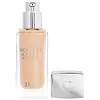What's inside
What's inside
 Key Ingredients
Key Ingredients

 Benefits
Benefits

 Concerns
Concerns

 Ingredients Side-by-side
Ingredients Side-by-side

Water
Skin ConditioningGlycerin
HumectantButylene Glycol
HumectantPPG-26-Buteth-26
Skin ConditioningPEG-40 Hydrogenated Castor Oil
EmulsifyingPhenoxyethanol
PreservativeCucumis Sativus Fruit Extract
EmollientPropylene Glycol
HumectantChamomilla Recutita Flower Extract
MaskingCamellia Sinensis Leaf Extract
AntimicrobialPolysorbate 20
EmulsifyingPEG-20 Glyceryl Laurate
EmulsifyingTocopherol
AntioxidantLinoleic Acid
CleansingRetinyl Palmitate
Skin ConditioningPanthenol
Skin ConditioningCaffeine
Skin ConditioningArginine
MaskingMica
Cosmetic ColorantCalcium Sodium Borosilicate
Tin Oxide
AbrasiveParfum
MaskingChlorphenesin
AntimicrobialDisodium EDTA
Sodium Benzoate
MaskingPotassium Sorbate
PreservativeDiethylhexyl Syringylidenemalonate
Skin ProtectingCaprylic/Capric Triglyceride
MaskingCI 77891
Cosmetic ColorantCI 77491
Cosmetic ColorantWater, Glycerin, Butylene Glycol, PPG-26-Buteth-26, PEG-40 Hydrogenated Castor Oil, Phenoxyethanol, Cucumis Sativus Fruit Extract, Propylene Glycol, Chamomilla Recutita Flower Extract, Camellia Sinensis Leaf Extract, Polysorbate 20, PEG-20 Glyceryl Laurate, Tocopherol, Linoleic Acid, Retinyl Palmitate, Panthenol, Caffeine, Arginine, Mica, Calcium Sodium Borosilicate, Tin Oxide, Parfum, Chlorphenesin, Disodium EDTA, Sodium Benzoate, Potassium Sorbate, Diethylhexyl Syringylidenemalonate, Caprylic/Capric Triglyceride, CI 77891, CI 77491
Water
Skin ConditioningC9-12 Alkane
SolventMica
Cosmetic ColorantDicaprylyl Ether
EmollientCoco-Caprylate/Caprate
EmollientPropanediol
SolventPolyglyceryl-6 Polyricinoleate
EmulsifyingDisteardimonium Hectorite
StabilisingPolyglyceryl-2 Isostearate
EmulsifyingLecithin
EmollientCopernicia Cerifera Wax Extract
Glycerin
HumectantPentylene Glycol
Skin ConditioningPolyglyceryl-10 Decaisostearate
EmollientHibiscus Sabdariffa Flower Extract
Skin ConditioningIris Florentina Root Extract
MaskingSodium Chloride
MaskingSodium Myristoyl Glutamate
CleansingHydroxyacetophenone
AntioxidantEthylhexylglycerin
Skin ConditioningEthylene Brassylate
MaskingSynthetic Fluorphlogopite
Potassium Sorbate
PreservativePropylene Carbonate
SolventParfum
MaskingAluminum Hydroxide
EmollientTocopherol
AntioxidantHydrolyzed Viola Tricolor Extract
Skin ProtectingCaprylic/Capric Triglyceride
MaskingPolyhydroxystearic Acid
EmulsifyingTin Oxide
Abrasive1,2-Hexanediol
Skin ConditioningCaprylyl Glycol
EmollientCitric Acid
BufferingIsostearic Acid
CleansingPolyglyceryl-3 Polyricinoleate
EmulsifyingSodium Benzoate
MaskingCI 77891
Cosmetic ColorantCI 77163
Cosmetic ColorantCI 77491
Cosmetic ColorantCI 77492
Cosmetic ColorantCI 77499
Cosmetic ColorantWater, C9-12 Alkane, Mica, Dicaprylyl Ether, Coco-Caprylate/Caprate, Propanediol, Polyglyceryl-6 Polyricinoleate, Disteardimonium Hectorite, Polyglyceryl-2 Isostearate, Lecithin, Copernicia Cerifera Wax Extract, Glycerin, Pentylene Glycol, Polyglyceryl-10 Decaisostearate, Hibiscus Sabdariffa Flower Extract, Iris Florentina Root Extract, Sodium Chloride, Sodium Myristoyl Glutamate, Hydroxyacetophenone, Ethylhexylglycerin, Ethylene Brassylate, Synthetic Fluorphlogopite, Potassium Sorbate, Propylene Carbonate, Parfum, Aluminum Hydroxide, Tocopherol, Hydrolyzed Viola Tricolor Extract, Caprylic/Capric Triglyceride, Polyhydroxystearic Acid, Tin Oxide, 1,2-Hexanediol, Caprylyl Glycol, Citric Acid, Isostearic Acid, Polyglyceryl-3 Polyricinoleate, Sodium Benzoate, CI 77891, CI 77163, CI 77491, CI 77492, CI 77499
Ingredients Explained
These ingredients are found in both products.
Ingredients higher up in an ingredient list are typically present in a larger amount.
This ingredient is an emollient, solvent, and texture enhancer. It is considered a skin-softener by helping the skin prevent moisture loss.
It helps thicken a product's formula and makes it easier to spread by dissolving clumping compounds.
Caprylic Triglyceride is made by combining glycerin with coconut oil, forming a clear liquid.
While there is an assumption Caprylic Triglyceride can clog pores due to it being derived from coconut oil, there is no research supporting this.
Learn more about Caprylic/Capric TriglycerideCi 77491 is also hydrated iron III oxide. It's sole purpose is to give a red/pink hue to products.
Iron III oxides are classified as inorganic chemicals for coloring.
Synthetically created Ci 77491 is considered safer than those naturally found. This is because the synthetically created version may contain less impurities. Iron oxides are generally non-toxic and non-allergenic.
Learn more about CI 77491Ci 77891 is a white pigment from Titanium dioxide. It is naturally found in minerals such as rutile and ilmenite.
It's main function is to add a white color to cosmetics. It can also be mixed with other colors to create different shades.
Ci 77891 is commonly found in sunscreens due to its ability to block UV rays.
Learn more about CI 77891Glycerin is already naturally found in your skin. It helps moisturize and protect your skin.
A study from 2016 found glycerin to be more effective as a humectant than AHAs and hyaluronic acid.
As a humectant, it helps the skin stay hydrated by pulling moisture to your skin. The low molecular weight of glycerin allows it to pull moisture into the deeper layers of your skin.
Hydrated skin improves your skin barrier; Your skin barrier helps protect against irritants and bacteria.
Glycerin has also been found to have antimicrobial and antiviral properties. Due to these properties, glycerin is often used in wound and burn treatments.
In cosmetics, glycerin is usually derived from plants such as soybean or palm. However, it can also be sourced from animals, such as tallow or animal fat.
This ingredient is organic, colorless, odorless, and non-toxic.
Glycerin is the name for this ingredient in American English. British English uses Glycerol/Glycerine.
Learn more about GlycerinMica is a naturally occurring mineral used to add shimmer and color in cosmetics. It can also help improve the texture of a product or give it an opaque, white/silver color.
Serecite is the name for very fine but ragged grains of mica.
This ingredient is often coated with metal oxides like titanium dioxide. Trace amounts of heavy metals may be found in mica, but these metals are not harmful in our personal products.
Mica has been used since prehistoric times throughout the world. Ancient Egyptian, Indian, Greek, Roman, Aztec, and Chinese civilizations have used mica.
Learn more about MicaParfum is a catch-all term for an ingredient or more that is used to give a scent to products.
Also called "fragrance", this ingredient can be a blend of hundreds of chemicals or plant oils. This means every product with "fragrance" or "parfum" in the ingredients list is a different mixture.
For instance, Habanolide is a proprietary trade name for a specific aroma chemical. When used as a fragrance ingredient in cosmetics, most aroma chemicals fall under the broad labeling category of “FRAGRANCE” or “PARFUM” according to EU and US regulations.
The term 'parfum' or 'fragrance' is not regulated in many countries. In many cases, it is up to the brand to define this term.
For instance, many brands choose to label themselves as "fragrance-free" because they are not using synthetic fragrances. However, their products may still contain ingredients such as essential oils that are considered a fragrance by INCI standards.
One example is Calendula flower extract. Calendula is an essential oil that still imparts a scent or 'fragrance'.
Depending on the blend, the ingredients in the mixture can cause allergies and sensitivities on the skin. Some ingredients that are known EU allergens include linalool and citronellol.
Parfum can also be used to mask or cover an unpleasant scent.
The bottom line is: not all fragrances/parfum/ingredients are created equally. If you are worried about fragrances, we recommend taking a closer look at an ingredient. And of course, we always recommend speaking with a professional.
Learn more about ParfumPotassium Sorbate is a preservative used to prevent yeast and mold in products. It is commonly found in both cosmetic and food products.
This ingredient comes from potassium salt derived from sorbic acid. Sorbic acid is a natural antibiotic and effective against fungus.
Both potassium sorbate and sorbic acid can be found in baked goods, cheeses, dried meats, dried fruit, ice cream, pickles, wine, yogurt, and more.
You'll often find this ingredient used with other preservatives.
Learn more about Potassium SorbateSodium Benzoate is a preservative. It's used in both cosmetic and food products to inhibit the growth of mold and bacteria. It is typically produced synthetically.
Both the US FDA and EU Health Committee have approved the use of sodium benzoate. In the US, levels of 0.1% (of the total product) are allowed.
Sodium benzoate works as a preservative by inhibiting the growth of bacteria inside of cells. It prevents the cell from fermenting a type of sugar using an enzyme called phosphofructokinase.
It is the salt of benzoic acid. Foods containing sodium benzoate include soda, salad dressings, condiments, fruit juices, wines, and snack foods.
Studies for using ascorbic acid and sodium benzoate in cosmetics are lacking, especially in skincare routines with multiple steps.
We always recommend speaking with a professional, such as a dermatologist, if you have any concerns.
Learn more about Sodium BenzoateTin Oxide is an inorganic oxide used to add opacity and volume to a product. In nature, it is already found in mineral form. The main ore of tin is an opaque and shiny mineral called casseterite.
Tin Oxide helps remove translucency in a product, or make it more opaque. Besides adding opacity, tin oxide is used for bulking to add volume.
Tocopherol (also known as Vitamin E) is a common antioxidant used to help protect the skin from free-radicals and strengthen the skin barrier. It's also fat soluble - this means our skin is great at absorbing it.
Vitamin E also helps keep your natural skin lipids healthy. Your lipid skin barrier naturally consists of lipids, ceramides, and fatty acids. Vitamin E offers extra protection for your skin’s lipid barrier, keeping your skin healthy and nourished.
Another benefit is a bit of UV protection. Vitamin E helps reduce the damage caused by UVB rays. (It should not replace your sunscreen). Combining it with Vitamin C can decrease sunburned cells and hyperpigmentation after UV exposure.
You might have noticed Vitamin E + C often paired together. This is because it is great at stabilizing Vitamin C. Using the two together helps increase the effectiveness of both ingredients.
There are often claims that Vitamin E can reduce/prevent scarring, but these claims haven't been confirmed by scientific research.
Learn more about TocopherolWater. It's the most common cosmetic ingredient of all. You'll usually see it at the top of ingredient lists, meaning that it makes up the largest part of the product.
So why is it so popular? Water most often acts as a solvent - this means that it helps dissolve other ingredients into the formulation.
You'll also recognize water as that liquid we all need to stay alive. If you see this, drink a glass of water. Stay hydrated!
Learn more about Water